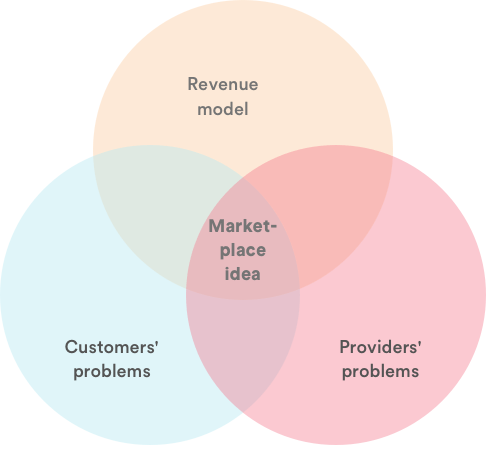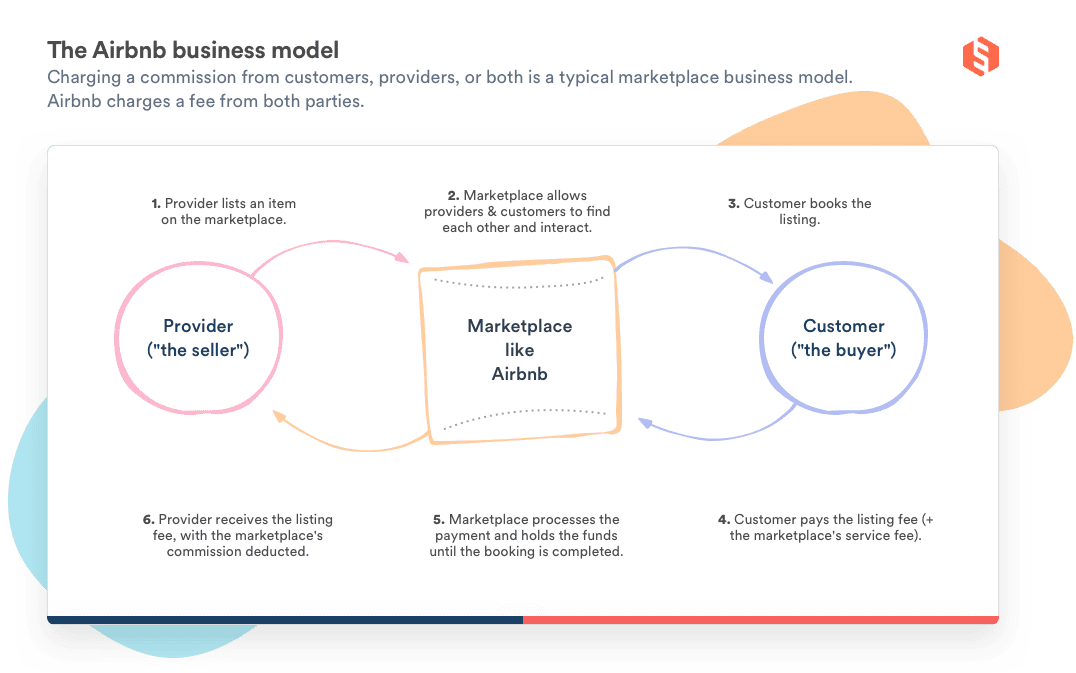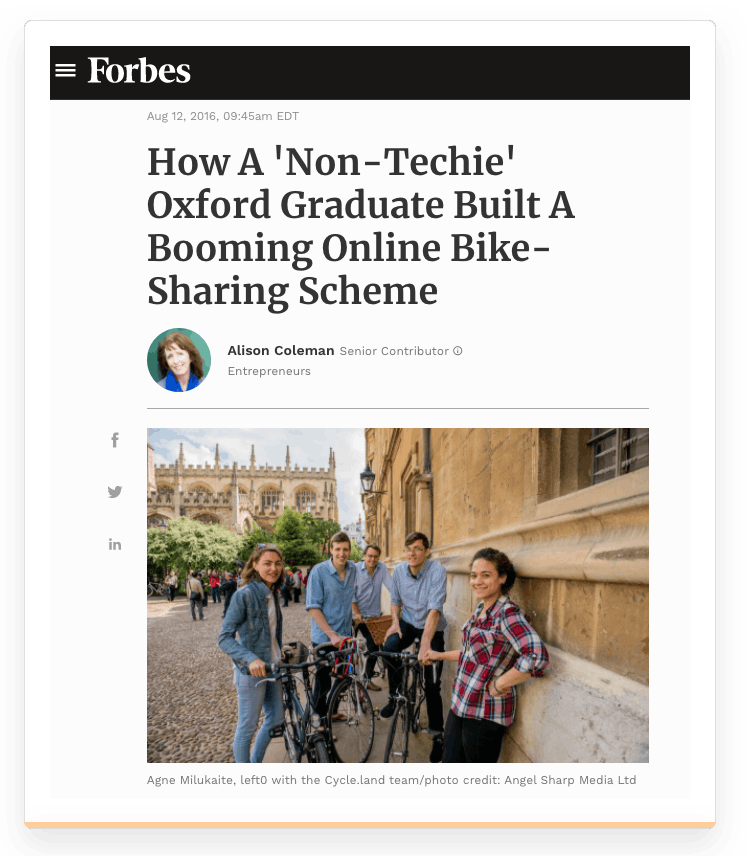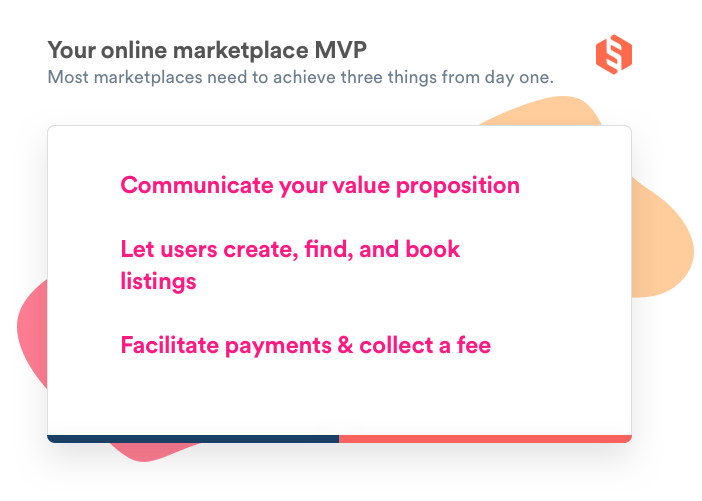How to build a website like Airbnb
It’s never been easier to launch a marketplace. Creating a successful marketplace business, however… that’s the real challenge. This guide aims to help you build a website like Airbnb — and get the business side working from day one.

Table of Contents
Chapter 1
Introduction: Start with an idea – that's what Airbnb did
The purpose of this guide is to help you follow a similar path as Airbnb did – build your marketplace website and business iteratively.
How Airbnb got started
Airbnb's origin story is legendary, not least because of what it says about the power of great ideas and constant improvement.
In 2007, an upcoming design conference filled up hotel rooms in San Francisco. Roommates Brian Chesky and Joe Gebbia decided to earn some extra by offering to host attendees on air mattresses.
The idea led to a simple website site that brought three people to stay at Chesky’s and Gebbia’s flat. A year later, Nathan Blecharczyk joined to start building a more feature-rich experience. The rest is history, with many entertaining stories from selling breakfast cereal to getting rejected by famous VC firms before reaching a valuation measured in billions.
Launching a website like Airbnb has become easier, quicker, and more affordable.
In sum, it took years of learning and iterating for Airbnb to reach the scale the company has now.
Today, launching a website like Airbnb is much easier, quicker, and more affordable than in 2007. But the core message and inspiration of the story of Airbnb remains unchanged.
The founders started with an idea. They identified an underused asset – people with extra living space – and an audience – travelers looking for an alternative to hotels. They came up with a solution that solves a big problem for both Airbnb user groups. They figured out a business model, launched a website quickly, and continued to improve the platform and the business side.
The purpose of this guide is to help you follow a similar path and succeed with your online marketplace business.
Whether you're using no-code marketplace software, building on top of API-based marketplace software, or coding your site from scratch, we hope this practical step-by-step approach will help you make the right choices at the early stages of your business.
How to build a website like Airbnb
To build a website like Airbnb, follow these five steps:
- Validate your idea as Airbnb did.
- Choose your business model.
- Define the key features.
- Choose how you’ll build your website quickly and affordably.
- Launch your MVP and plan a growth path.
In the following chapters, I'll go through each of the five steps in more detail and give practical advice to help you build your marketplace.
Before we dive into the steps, it's helpful to understand how Airbnb works. In a nutshell, Airbnb could be described as a...
- location-based
- peer-to-peer
- rental marketplace.
The term location-based means that the customer needs to be at the same location as the listing to make a transaction. This affects both feature requirements and business strategy.
Peer-to-peer describes Airbnb’s primary user groups. On P2P marketplaces, private individuals can act as sellers, buyers, or both. B2C or B2B marketplaces similar to Airbnb can also be successful, but they might require slightly different functionality.
A rental marketplace brings together people who have idle assets with people who want to rent those assets. A rental website needs different features than product-selling marketplaces like Amazon or eBay. The rented item can be spaces or anything from swimming pools to music studios to cameras. (For more rental marketplace inspiration, check out great Sharetribe examples in our customer gallery!)
With these building blocks in mind, let's dive into step one: validating your business idea following a path similar to Airbnb's.
Chapter 2
Validate your idea, inspired by Airbnb
Talk to your potential users before you start building your website.
Great marketplace ideas solve a real problem for both user groups: the supply and the demand.
Airbnb did that from day one: their first customers needed a place to stay but couldn’t find one. Their first suppliers (the founders themselves!) had extra space but needed additional income.
How can you make sure you’re solving a real problem as Airbnb did? By talking to your potential users.
Solve a problem for your users better than any existing solution.
You can start doing that even before spending any time or money on building your actual marketplace website. Start validating your startup idea by identifying who your target audience is, what problem you assume it has, and how your concept offers an improvement. Then validate all these assumptions by talking to relevant people. Remember to do this for both sides: providers and customers.
As you research your target market, you may find another marketplace in your space. Don't let that discourage you. If you can solve a real problem for users better than any other existing solution, you have a window of opportunity.
For location-based businesses, in particular, the best strategy usually is to focus. Find one vertical and one geographic area, and focus your energy on winning them. Later, you can start scaling location by location.
In addition to solving a problem for providers and customers, you also need to validate your business model. Are you able to generate revenue to run and grow your marketplace?

That's why the next step after validating your idea should be to find the right business model for your marketplace.
(For more on marketplace ideas, check out our articles on how to come up with a great marketplace idea, how to validate your idea before building a platform, and how to focus your marketplace on one city and one vertical.)
Chapter 3
How does Airbnb make money – choosing a business model
How an entrepreneur makes money with a website like Airbnb.
There are a few business models you can use to generate revenue.
- Commission: charging a flat fee or a percentage out of each transaction.
- Membership: charging a subscription fee for joining the platform.
- Listing fee: charging a fee when a provider posts a listing.
- Lead fee: charging providers for access to customers.
- Freemium: charging for additional features, but core features are free.
- Featured listings/ads: charging providers or other businesses for visibility.
When validating your business idea, make sure you also think about your monetization model. Consider which one offers you the most reliable income and allows you to scale your business.
Commission is the most common marketplace business model. Platforms such as Airbnb, Amazon, Etsy, Upwork, and Fiverr all use commissions as their primary revenue stream.
Airbnb makes money by charging a commission, or a service fee, from both providers and customers. Especially in the early stages, it’s typical to charge a commission from the providers only. This helps keep the entry barrier low: customers don’t need to pay extra, and providers only pay a fee when they make money.

A customer commission works when the platform provides enough value to customers to justify it. This does happen in Airbnb’s case.
A drawback of the commission model is that it can be complicated to build and usually requires a dedicated marketplace payment solution. Next, we'll look more closely at payments and other features of sites like Airbnb.
(You can find more on marketplace monetization in our articles about choosing the right marketplace business model, setting your marketplace pricing, and preventing platform leakage.)
Chapter 4
Airbnb core features
A website like Airbnb needs a set of essential marketplace features from day one.
The features on Airbnb are very different from those offered by traditional online stores and product-selling marketplaces.
Here are are the essentials:
 Profiles and listings
Profiles and listings
On Airbnb, a large number of customers & providers interact and make transactions.
To do so, Airbnb users need to create a user account and publish and update descriptions about themselves (user profiles) and their offerings (listing pages) on the site. Informative, nicely designed profiles and listings help boost your marketplace conversion rate and increase trust between users.
 Map and location search
Map and location search
On traditional e-commerce marketplaces like eBay, location doesn't matter since products can be shipped worldwide. On location-based marketplaces like Airbnb, customer and provider (or the provider’s offering, at least) need to be physically close to each other.
A location-based marketplace can’t get by without a powerful search engine that allows users to look for listings in their ideal location. Showing listings on a map is essential, as well.
Facilitating payments allows you to charge a commission from each transaction.
 Online payments
Online payments
Classified sites like Craigslist connect customers and providers locally but don't facilitate payments between them. Peer-to-peer rental marketplaces allow the customer to make the booking and payment through the site.
Robust payment features make using the platform easy and convenient, which, as you remember, is crucial for building a successful platform business. Facilitated online payments are also safer than dealing with cash or direct payments. Finally, offering payments allows the marketplace operator to charge a commission from each transaction.
 Reviews after transactions
Reviews after transactions
Peer-to-peer marketplaces are based on trust between strangers. Online stores and platforms like Amazon usually ask customers to review the sellers. But on a peer-to-peer marketplace such as Airbnb, providers also need to be sure the customers are trustworthy.
That’s why two-sided review functionality is a must. After a transaction, the customer reviews the provider, and the provider reviews the customer. Public reviews increase trust, and great reviews tend to boost sales as well.
 Availability and booking management
Availability and booking management
When a marketplace offers services or rentals, providers need a reliable system to specify when their listings are available. Customers should only be able to browse and book listings that are available during their desired dates. When a listing is booked, it should automatically be defined as unavailable for the booking period.
This feature is a crucial part of the value proposition of a rental marketplace like Airbnb. It helps providers make the most of their offering, boosts successful transactions, and avoids the frustration of double-bookings.
 Delaying payments or holding funds
Delaying payments or holding funds
Many Airbnb-like businesses add a layer of trust with a feature called delayed payouts. When payouts are delayed, customers pay for a listing right away when they book it. The provider, however, receives the money only after the booking is concluded.
Delaying payouts is a powerful way to ensure both the providers and the customers of a marketplace make bookings with honest intentions.
All these essential features and lost more are included with both Sharetribe marketplace solutions.
 Admin tools
Admin tools
Succeeding with a marketplace will require daily monitoring and management. As a marketplace admin, you'll want to be able to send notifications to your users, moderate user-generated content like profiles and listings, control user access, see your transaction processes, and so on.
Chapter 5
Technology: Choose how you build your Airbnb website
There are many ways to create a website like Airbnb. Each has its pros and cons.
When Airbnb first launched, online marketplaces were something completely new. While many things have changed since the early days of Airbnb, coding a similar location-based peer-to-peer rental marketplace continues to be an extremely complicated, time-consuming, and expensive project.
Luckily, today’s marketplace entrepreneurs have alternatives that don't require development skills or massive budgets.
For an in-depth analysis, check out our article on the six different ways of developing a marketplace website. Here, we’ll look at the three most common methods of building a marketplace website: coding from scratch, using a no-code SaaS tool, and using an API-based headless marketplace solution.
Code from scratch
Custom development gives you lots of freedom to build and design your marketplace. But a marketplace is far more complex than your average web application. The development process is extremely time-consuming and heavy on upfront costs.
If you’re not technical, hiring a developer will require a budget in the five figures. Though development costs vary between agencies, even the most cost-efficient choice will likely set you back north of $50,000 to launch your site. That sum won't include the cost of third-party tools, maintenance, updates, hosting, or monitoring – these costs will happen on a monthly basis.
Custom development gives you freedom but is heavy on upfront costs.
If you’re a software development expert, the budget is more accessible. If you can build the frontend and backend yourself and are willing to take on the maintenance work, the costs will be limited to hosting and third-party tools. You can benchmark the Airbnb technology stack or get to work using the technologies you're familiar with. Any programming language (Ruby, PHP, JavaScript, Python, Java, Clojure...) can be used.
However, even if there are no costs from the actual development work, your time as a marketplace founder is valuable. Custom developing a marketplace will take several months of focused work. In the early stages, that time would be far more effectively spent on creating a few unique, key features and building your user base.
If you're interested in exploring this option further, I highly recommend this article on marketplace apps by our senior full-stack developer Mikko. It's a detailed guide to building a marketplace app from scratch and helps you estimate the scope of the project, choose your technology stack, and prioritize features and functionality.
Build a marketplace fast with no-code software
If you have a business idea that works very similarly to Airbnb, using a marketplace Software-as-a-service (SaaS) tool is by far the fastest way to market.
For example, our customer Mike launched a rental marketplace for music studios in one day with Sharetribe Go (and grew it with Sharetribe Flex into the world’s largest).
Marketplace SaaS is also the easiest choice in terms of the technical skills required. If your software gives you the essential marketplace website features, you can create a website similar to Airbnb in a matter of days instead of months. You won't need to worry about hosting, maintenance, backups, or updates – and can launch and run a marketplace entirely without coding.

This is great if you're not a developer — and even if you are, this approach lets you validate your idea and find a product-market fit without spending months building your website.
Building your marketplace with a ready-made tool doesn't give you the same freedom as custom development. However, a SaaS tool is great for validating your marketplace idea and building your minimum viable platform. It lets you launch your site fast and learn about your audience. Later, you can move on to a more custom-built solution to grow your business.
For the next stage, an API-based marketplace software solution is a great alternative.
Custom-develop on top marketplace APIs
Headless, API-based marketplace software aims to combine the benefits of both custom-development and no-code marketplace tools. Sharetribe Flex is a pioneer in this category, and it's specifically designed to power a rental marketplace website like Airbnb.
First, Flex gives you all the essential marketplace features out of the box. You won't have to devote any time to building mandatory marketplace features that users take for granted. This cuts the time to market and costs by as much as 90% compared to coding a marketplace from scratch.
At the same time, the freedom of custom coding is preserved. An API-based architecture allows you to develop unique features and third-party integrations on top of your marketplace. You’re also free to design and build your unique user interface.
A third big benefit is that Flex takes care of maintenance, security compliance, updates, and so on. Even when your marketplace grows into a global business, you won't have to dedicate development time to mandatory maintenance tasks. Instead, you can use that budget for building great, unique features and taking advantage of the regular updates Flex offers.
A drawback of this approach is that it will require more time and technical skills than a hosted, no-code tool. Therefore, my recommendation is to create the first version of your Airbnb-like marketplace with a ready-made solution. After you've validated your idea and generated revenue, you can take your business to the next level with Sharetribe Flex. A great way to get started for non-technical founders is to hire one of Sharetribe's vetted Flex Experts for custom marketplace development. You'll have a developer who knows both marketplaces and Sharetribe Flex.
An API-based marketplace solution can cut the cost of building and time to market by 90%.
In addition to these three approaches, there are several other ways to create a website like Airbnb. For example, it's possible to use a generic website builder with plugins or combine a set of no-code tools. While none of these can quite match the speed to market of dedicated no-code marketplace software or offer the same flexibility as custom development, they may fit your specific situation. If you're looking for the right approach for you, have a look at our articles on the six approaches to marketplace development, choosing the right marketplace software, and designing a marketplace transaction flow.
How much does it cost to create a website like Airbnb?
As you previously learned, Airbnb-like platforms need to handle complicated functionality like filtered searching, geolocation, online payments, communication between the users, and review systems. Building such a site from scratch requires a lot of work and technical skills, and that's why outsourcing development nearly always costs well over $50,000.
Using dedicated marketplace software can help you save both money and time. Here are two example budgets for the first year of running a marketplace with Sharetribe Go and Sharetribe Flex.
Create a marketplace with Sharetribe Go
| Pro subscription of Sharetribe Go for 12 months (semiannual billing) | $1,428 |
| Domain registration for 12 months | $10 |
| Logo design – free (using a tool like Canva) | $0 |
| Stock images – free (using a service like Unsplash) | $0 |
| Wordpress blog for marketing | $100 |
| MailChimp email marketing – free up to 2,000 subscribers | $0 |
| Google Analytics – free version | $0 |
| Total 1st year marketplace budget with Sharetribe Go | $1,538 |
In this example budget, we assumed you're using Sharetribe Go to validate your idea and build your MVP and want to keep costs to a minimum.
In addition to building a website, you’ll likely need to spend some money on building your brand and marketing your site. On top of the costs in the table, you may want to outsource design, buy fonts, images, or certificates, and pay for ads or marketing solutions. However, there’s a lot you can do with affordable or free online tools.
Sharetribe Go is free to try for 30 days; you can start your trial here.
Moving your marketplace to Sharetribe Flex
| Sharetribe Flex subscription for 12 months (annual billing) | $3,588 |
| Sharetribe Flex transaction fee – $0 up to $30,000 in monthly transaction volume | $0 |
| UX design and wireframes | $1,500 |
| Flex development | $5,000 |
| Front-end hosting | $360 |
| Wordpress blog for marketing | $300 |
| MailChimp Standard plan for up to 25,000 subscribers | $2,628 |
| Google Analytics – free version | $0 |
| Total 1st year marketplace budget with Sharetribe Flex | $13,376 |
At this stage, you probably know your target audience well and have already generated some revenue to fund developing your next marketplace version. Sharetribe Flex is specifically designed to power websites similar to Airbnb so that you can get by with minimal customization work. However, please note that this budget is a rough estimate – prices for designs and development vary greatly depending on the experts’ hourly fees and the extent of customizations you need for your idea.
Developing with Flex is free for an unlimited time. That means the monthly fee doesn't start applying until you are ready to launch your marketplace. You create your Flex account and start developing for free here.
Chapter 6
How to launch your MVP
The best way to test your startup idea? Launch your first version as quickly as possible.
As the example of Airbnb shows, building a successful marketplace business takes constant learning and improvement. The surest way to succeed is to focus on a clearly defined target audience and fulfill their needs better than anybody else.
You’ll only know if your idea truly achieves that when you launch your site.
The first version you launch should be an MVP (Minimum Viable Product). It’s the minimal version of your platform that solves a core problem for your most important users better than any other existing solution.

Minimal shouldn’t be confused with mediocre or basic. The MVP approach encourages you to find the fastest, easiest way to deliver your very first customers a remarkable experience. Your minimum viable product should communicate your unique value proposition, let users interact, and allow you to test your business model.
The fastest way to get a fully functional marketplace MVP out into the world is using a no-code software tool like Sharetribe Go. Depending on your idea, you might even get forward with a simple website, matching your customers and providers manually! Whichever solution lets you launch fast while still delivering a great customer experience, that’s what you should go for.
Our articles on building a Minimum Viable Platform and communicating your value proposition can help you with scoping out your minimum viable product.
Chapter 7
Conclusion: How to build a business like Airbnb
Building a successful marketplace is a process.
Creating a successful marketplace business is a big challenge. Building a powerful marketplace website is an important step but not the whole story. What counts is how quickly you'll be able to learn about your users and solve their biggest problems.
The surest way to succeed is to focus on a clearly defined target audience and answer their needs better than anybody else. You'll start learning about both when you launch your site.
The faster you launch, the quicker you can start learning about your audience. The more you learn, the better you can develop your offering to serve your audience better than any other solution.

Sharetribe’s solutions have been developed with this process in mind. Sharetribe Go is designed for launching fast and jumpstarting the learning process. Sharetribe Flex comes in when you want to develop your business further.
But no matter which solution you choose, I hope this article helps you embrace the iterative approach. Validate your idea by first talking to potential users. Find a business model that supports you through the early stages and helps you grow. Identify your core features, choose a fast way to build them, and launch your minimum viable product.
If you're interested in reading more about the steps of building a marketplace, check out our How to start an online marketplace guide. It offers lots of expert advice for marketplace entrepreneurs that you can apply regardless of how you decide to build your website.
Best of luck with your marketplace business!
Examples of Airbnb-like marketplaces built with Sharetribe
Find inspiring examples of Sharetribe-powered marketplaces by browsing through our customer gallery and customer stories!

"Thanks to Sharetribe, I was able to build a profitable business in 6 months."
An Airbnb for record studios, Studiotime has 5% of all the record studios in the world listed on their platform.

"Without Sharetribe, it would have been impossible for me to pursue my dream and start my company."
An Airbnb for surfboard rentals, the Quiver is the largest online marketplace for surfers to share boards.

BoatEasy
A peer-to-peer marketplace for boating services

Jardins Privés
A marketplace for renting private gardens

Cycleland
A peer-to-peer marketplace for bicycle rentals
